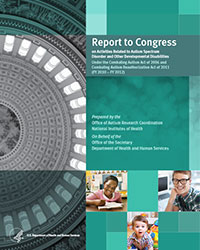Report to Congress
On Activities Related to Autism Spectrum Disorder and Other Developmental Disabilities
FY 2010 - FY 2012
This section addresses subsection (5) of 399DD: "Information on the average age for intervention for individuals diagnosed with ASD and other developmental disabilities, including how that age may have changed over the 4-year period beginning on the date of enactment of this Act." Information on the average age of intervention for individuals with ASD is provided by the CDC.
Centers for Disease Control and Prevention (CDC)
CDC monitors progress on the Healthy People 2020 objective of increasing the proportion of children with ASD who receive a comprehensive evaluation by a qualified professional before age 3. A baseline of 39 percent was established for 2010 (based on data from the ADDM 2006 surveillance year), with a goal of increasing this proportion by 10 percent during 2010-2020, or 2 percent in each of the 5 biennial surveillance years between 2006 and 2016. For the first reporting period, based on the 2008 surveillance year, the proportion of children with ASD receiving a comprehensive evaluation by age 3 increased from 39 percent to 41.8 percent. This represented a 7 percent increase over baseline, exceeding the 2 percent target. The more recent numbers are also higher than previous numbers from 2000-2004, where only about 32-33 percent of children with ASD received a comprehensive evaluation by age 3. This provides evidence that more children with ASD are being evaluated at an early age, which may indicate that more children with ASD are receiving interventions by age 3 as well.
The six Early ADDM sites described previously, funded in 2010 to monitor ASD prevalence among children at age 4, have begun collecting data on specific interventions children were receiving by that age. Findings from the first Early ADDM study are expected to be published in 2014.




